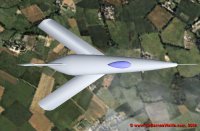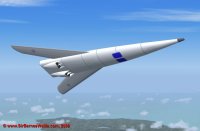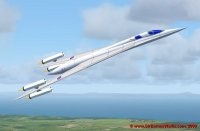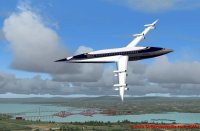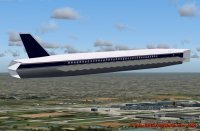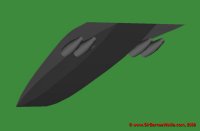Supersonics
Wild Goose
Even before the end of World War II, Wallis (like many other designers) recognised that the next big milestone in flight would be a supersonic aircraft, and his main interest became the development of a supersonic airliner. It was recognised that the increase in drag at supersonic speeds would require very efficient aerodynamics, and as a leap towards this target (and to reduce weight), Wallis proposed to dispense entirely with the tail for his new aircraft. He also wanted to exploit the idea of laminar flow to produce a fuselage with very low skin drag. The basic form of his new aircraft (which he called an aerodyne) thus had just three structural elements, an egg-shaped fuselage and two wings (which had no flaps or ailerons).
Although potentially offering efficient flight characteristics, this new form of aircraft clearly presented substantial control problems. To solve these, Wallis used his unique knowledge as an airship designer - he knew that when an elongated solid body (like an airship or aircraft fuselage) travelled through the air at a slight angle, it generated large rotational forces but no substantial linear forces. To balance these rotational forces, Wallis planned to locate the wings towards the rear of the aircraft (giving rise to the aircraft’s name - Wild Goose - as geese also have their wings far back on their bodies) giving an inherently stable form. Control was to be effected by pivoting the wings (round a vertical axis) - sweeping the wings backwards would allow faster speeds, while sweeping them forward would give greater lift for landing and take-off. To change direction, he proposed to sweep the wings asymmetrically, the aircraft turning towards the wing that was swept the most. This was the “wing-controlled aerodyne”, though later the concept would become better known as “variable geometry”.
Due to this being an entirely new form of aircraft, and also due to his desire never to kill another pilot (stated following the Dams Raid), Wallis was set against using manned test aircraft, and instead proposed using large radio-controlled models to demonstrate the feasibility of his ideas. A series of models, both gliders and rocket-powered, were constructed for the test programme - this took years to set up, as the remote guidance system, rocket motors, launch trolleys (also rocket powered) and myriad other systems had to be designed and built to support the operation of the aircraft.
Preliminary tests of the Wild Goose model took place at Brooklands in June 1949, before moving to a larger site at RAF Thurleigh in Bedfordshire, with the first (unsuccessful) releases being made later in the summer. The model was mounted on a vertical shaft above the rubber-tyred trolley, which was also remotely controlled by radio. The aircraft was set to release from the trolley when the lift generated was greater than the weight of the aircraft, then guided round the circuit. Tests continued through the winter, with the first powered take-off being made in February 1950. Building work at Thurleigh meant that it was not available after June, and a new test site had to be found; the location chosen was Predannack in Cornwall, site of a wartime naval air station. A section of railway track was built parallel to the main runway, and a new more powerful trolley constructed; this, as well as changes to the control systems in the aircraft, meant that test flights were only able to be resumed in the summer of 1951. Following many ground runs, more than 30 powered flights of Wild Goose were made between 1952 and 1954.
Plans were drawn up for a piloted version of Wild Goose, which was to be built by Heston Aircraft as the Heston JC-9. Construction was cancelled in mid-1952 when well advanced; the reasons for the cancellation (as well as the decision to build it) remain unclear. Later that year, a photo-reconnaissance aircraft based on the Wild Goose principles, with some further conceptual changes, was designed, but this did not advance beyond the planning stage following a poor preliminary assessment by the RAE.
Swallow
Even as the Wild Goose experiments continued, Wallis realised that he was not going to get the range required from the design. By 1953, the “slender delta” planform was the favourite of designers of supersonic aircraft, and he knew that most of the lift from this shape came from the leading edge. He therefore proposed an arrowhead planform using a delta, but with the non-lifting rear part removed, and with the wings projecting backward from a smaller delta-shaped forebody (which also provided lift). Having the wings so far back would make take-off and landing problematic, so he reverted to his variable-geometry wing concept, pivoting the wings at the rear of the forebody, so that they could be swept forward - almost straight - for low-speed manoeuvring and landing.
Experience with Wild Goose meant that he had a model ready within three months of conceiving this new shape, the trailing wings suggesting the name Swallow. Ground runs on the rail trolley were made at Predannack in 1954, but it was decided that Swallow would take off from the runway in a conventional fashion, the wings locked in the low-speed configuration. The first flight was made in November 1955, a full circuit and a safe (though bumpy) landing being achieved at the first attempt. Supersonic models were also flown via a rocket launch at a military rocket range, which proved that the Swallow shape was stable at supersonic speeds. Loss of a subsonic model over the sea on a subsequent flight brought the test programme to a close prematurely (the lease on Predannack was ending in autumn 1957 anyway), but the concept was proven and a manned test aircraft seemed the inevitable next step, and several Swallow-based designs were developed in substantial detail.
However, 1957 brought the Sandys Defence White Paper, which led to drastic cut-backs in all aspects of the Armed Forces, the RAF being particularly badly affected. Nearly all aircraft development projects were cancelled, Swallow among them. Wallis looked for other funding sources for a couple of years, eventually visiting NASA’s Langley facility. Early US tests with variable geometry had been unsuccessful, but Wallis’s approach appeared more workable - however, the Americans did not fund Wallis’s work, instead making developments on his ideas themselves, leading directly to the General Dynamics F-111. Vickers considered suing the Americans for infringement of their variable geometry patents, but the idea was dropped.
Wallis produced a Swallow version of OR.339 (which became TSR.2) and also tried to push the Swallow as the basis for the British SST (later Concorde), but the plain slender delta was chosen instead. However, the benefits offered by variable geometry were eventually realised and numerous VG aircraft appeared, although the Tornado was nearly the last of them, despite the early UK lead established by Wallis.
Beyond Supersonics
By 1960, Wallis realised that Mach 2.5 (the speed limit on the slender delta) was too slow (the Americans had a Mach 3 SST in prospect), and he produced a new design for an “all-speed” aircraft this time with a top speed of Mach 4-5. The best shape for a hypersonic wing was of low span (i.e. short) and of high chord (i.e. long from leading to trailing edge); however, such a shape is very poor for low-speed flight. Wallis thus proposed to break the wing into a series of winglet pairs, each pair pivoted on a common axis running across the fuselage. When “closed”, the winglets would form a single high-chord wing, but when pivoted (leading edge upwards), they formed in effect a series of flaps, giving large amounts of lift - rather in the fashion of a venetian blind. Wallis developed designs for several forms of this “Cascade” aircraft, ranging from a one-man reconnaissance aircraft to a 100-seat passenger aircraft that could have taken off from a 300-yard runway and flown 10,000 miles at speeds in excess of Mach 4.
Contemporary designers exploring speeds in this range were being challenged by the materials problems associated with the heat generated by the air friction. Solutions to these used materials like stainless steel and titanium for the airframe. However, Wallis was keen to continue to use light alloys, but devised an “isothermal flight” profile which balanced increasing speed with increasing height (and hence thinner air), allowing the airframe temperature to remain within safe limits.
Wallis’s experimentation with new forms continued, and he realised that he could get a similar effect to the Cascade aircraft by using one single wing (still pivoted on a horizontal shaft) with large leading- and trailing-edge flaps. This (and in some versions, a bending fuselage to give a partially downward exhaust from the engines) allowed the configuration of the aircraft to be continually altered for the wide range of different flight regimes encountered between take-off and a cruise at above 100,000ft and Mach 4. As the aircraft was in the most efficient configuration at all times, range could be maximised, and a non-stop London-Sydney flight was believed to be achievable with this "universal" aircraft.
Wallis did very briefly dabble with VTOL, but the weight penalties were too large for his main goal of long range, and he preferred STOL designs, even proposing that the “airport of the future” should contain many short runways rather than just a few long ones, just as a railway station has many platforms to allow more frequent departures.
Throughout the 1960s and into the 1970s (even after his official retirement in May 1971), he continued to work on various novel aircraft configurations, but none of these left his drawing board.








